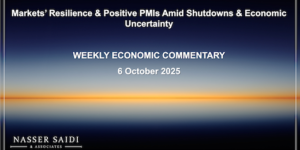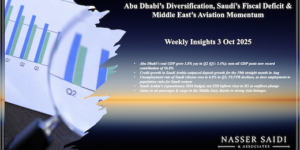Global Trade Wavers. Will Non-Oil Continue Supporting GCC Growth? Weekly Insights 10 Oct 2025
1. Middle East PMIs indicate robust non-oil sector activity in Q3 2025
- Non-oil private sector activity in the GCC captured by PMIs highlights a demand-led expansion in Sep, with Lebanon staying expansionary for the second month in a row (though the year-ahead expectations turned more pessimistic). Egypt’s wholesale & retail firms posted the sharpest declines in activity.
- GCC PMIs have been supported by new orders and output growth though the pace has been different. Output in Saudi posted the largest one-month gain in 4 years. New orders rising to a 7-month high in the UAEand discounting supported the rise in Kuwait’s new export orders. In contrast, new orders declined in Qatar(for the 4th month in a row) and Egypt (fastest pace in 5 months). In Lebanon, rates of growth in output and new orders hit fresh survey highs. Job creation was strong in the GCC, with Qatar also continuing to record strong wage inflation.
- Easing input costs in Saudi Arabia, Kuwait and Egypt (in the latter, partly due to the strengthening of EGP vis-à-vis the USD) contrasted with the UAE’s acceleration (though salary inflation eased). Input costs were passed on to consumers in UAE (only partly due to strong competition) and Egypt (for the 5th straight month) while in Qatar output charges rose for the first time since Jul 2024. Lebanon continued to suffer from rapid rises in input costs (fastest pace in over two years) & output prices (the most since Mar 2013), a hallmark of its ongoing stagflationary crisis.

2. Bahrain’s GDP grew by 2.5% yoy in Q2, largely owing to a non-oil sector boost (3.5% in Q2); FDI into financial sector accounted for almost two-thirds of total
- Real GDP in Bahrain grew by 2.5% in Q2 (Q1: 2.7%), supported by a 3.5% gain in non-oil sector activity. The non-oil sector contributed 85.2% to real GDP in Q2. A slight decline in oil production led oil GDP to decline 2.6% (vs Q1’s 5.3% expansion).
- In the non-oil non-govt sector, professional, scientific & technical sector posted the highest growth in Q2: 12.0% yoy in Q2 & 7.3% in H1, thanks to an uptick in management consultancy firms & compliance services (ahead of the implementation of the Domestic Minimum Top-up Tax for MNEs).
- GDP grew by 2.6% in H1, with oil & non-oil GDP up by 1.2% and 2.9% respectively.
- Financial & insurance sector remains the cornerstone of Bahrain’s non-oil economy. It grew by 4.9% in H1, with Q1 recording a stronger growth of 7.5% vs Q2’s 2.4%. The sector, which accounted for 65% of inward FDI stock, also contributed most to real GDP in Q2: 17.0%, followed closely by crude petroleum & natural gas (14.8%) &manufacturing (14.2%).
- Tourism & hospitality sector has also posted robust growth in H1, up by 7.5% in H1 (Q1: 10.3% & Q2: 4.6%), partly due to a series of successful international events. This has also boosted ancillary sectors like retail and transportation.
- Manufacturing, particularly aluminum production & downstream industries, continued to expand (+0.3% in H1), supported by strategic government investment and a focus on increasing non-oil exports. FDI into the sector accounted for 13.3% of total in Q2.

3. Saudi industrial production grew by an average 3.4% in Jan-Aug 2025, driven by non-oil activities (3.1%)
- Industrial production in Saudi Arabia grew by 1.4% mom and 7.1% yoy in Aug. Oil activities expanded by 1.7% mom and 8.3% yoy, as crude oil production rose (given the OPEC+ decision to unwind production cuts). Manufacture of coke & refined petroleum products surged by 8.9% yoy and 0.4% mom. Extraction of crude petroleum & natural gas increased by 8.1% yoy, the fifth month of upticks, and after double digit declines in H1 2024.
- Non-oil activities increased by 0.7% mom and 4.4% in Aug – evidence that the industrial expansion is not solely dependent on crude oil extraction. Within manufacturing, the manufacture of non-metallic products was the fastest growing (11.5% yoy) followed by chemicals & chemical products (8.6%).
- In Jan-Aug, non-oil manufacturing ticked up by 2.6% alongside a 7.1% surge in the manufacture of coke & refined petroleum products. Under non-oil manufacturing, non-metallic products grew the fastest (9.2%).
- The momentum in manufacturing will be fuelled by the pipeline of projects that will generate a durable demand for a wide range of industrial goods. Forward looking indicators such as the non-oil sector PMI and private sector credit growth underscore robust demand, which typically translates into higher industrial output.

4. Oil & gas exports account for close to two-thirds of Oman’s overall exports ytd; GCC visitors accounted for lion’s share of tourists in Aug
- Oil and gas exports accounted for close to two-thirds of Oman’s overall exports in Jan-Jul 2025 (63.7% vs 69.7% in Jan-Jul 2024). Exports fell by 9.2% yoy to OMR 13.5bn (as oil & gas exports plunged by 17.0% yoy to OMR 8.58bn). Imports increased by 5.5% to OMR 9.9bn – resulting in a narrower trade surplus (OMR 5.43bn in vs OMR 3.56bn in Jan-Jul 2024).
- Non-oil exports during the year grew by 11.2% yoy to OMR 3.9bn; this comprised mainly mineral products (OMR 1.04bn, up by 2.5% yoy, but accounting for 7.7% share of total exports) and base metals & articles (OMR 789mn). Re-exports inched up by 0.5% to OMR 1.0bn, with electrical machinery & equipment and transport equipment accounting for 27.5% and 27.3% of total re-exports respectively.
- UAE was Oman’s largest non-oil trade partner: non-oil exports to UAE grew by 27.8% yoy to OMR 698mn in Jan-Aug 2025, while re-exports were OMR 394mn (4.5%). Oman’s imports originated mainly from GCC:UAE was Oman’s largest source of imports (OMR 2.34bn, or 23.6% of total); along with Kuwait and Saudi, the 3 countries accounted for 40.5% of imports.
- Oman reported a 5.0% yoy drop in inbound tourists to 2.56mn in Jan-Aug 2025. UAE accounted for 30% of overall visitors during this period, while India and Germany were the top source nations from Asia and Europe (16.4% and 2.8% of total visitors). During the summer month of Aug, majority of visitors came from the GCC (56% of the total) while shares of visitors from Europe and Asia & Oceania nations stood at 6.9% and 25% respectively.

5. Global trade is forecast to grow by 2.4% yoy in 2025, before slowing to 0.5% in 2026: WTO
- The World Trade Organisation, in its latest Global Trade Outlook and Statistics report, forecasts global trade to grow by 2.4% yoy in 2025: this was partly supported by businesses in the US frontloading orders in anticipation of US tariff hikes and due to higher demand for in AI-related goods (e.g. semiconductors).
- However, trade volume growth is estimated to slow drastically in 2026 (0.5%), partly a delayed impact of tariff hikes and generally slower global growth.
- Export growth will be strong in Asia this year (along with Africa) though in 2026 both regions are expected to stay flat.
- Middle East exports are forecast to grow by 2.0% this year, slightly slower than last year’s 3.7% gain. The region had the largest downward revision to its export forecast for 2026, signaling significant headwinds.
- The region’s export profile, while diversifying, remains heavily influenced by the energy sector. A cooling global economy in 2026 would naturally lead to softer energy demand & prices, directly impacting export revenues.
- For the Middle East, the key to navigating this will be to accelerate its non-oil export strategy and continue investing in its digital economy to build resilience against a more turbulent global trade backdrop.
- Trade in commercial services remains a bright spot in the region, with growth projected at a healthy 4.4% in 2025 and 3.9% for 2026 – a critical buffer in this challenging environment.
6. Global trade was strong in H1 2025 but signs of weakness ahead
- Trade volumes by region (charts below) shows data till H1 2025, with exports from Asia leading growth (+10.4% in Q2 2025); North America grew at a slower pace (3.0%) & Middle East was up by 3.7%. CIS exports declined by 1.5%. On the imports side, all regions posted positive yoy growth in H1 2025.
- Asia is expected to make the largest positive contribution to trade growth this year though slowing in 2026. In contrast, after a strong H1 2025, North America trade flows will make a negative contribution to trade growth in 2025 and 2026.
- PMI readings are showing signs of weakness in trade and manufacturing output especially in developed economies; furthermore, reduced business and consumer confidence as well as slower growth in employment and incomes will impact overall demand for and purchases of goods and services.

Powered by:









